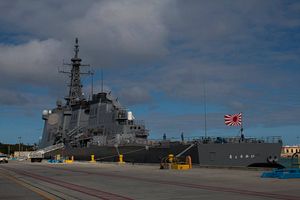The U.S. Navy and Japan Maritime Self-Defense Force (JMSDF) are holding their annual war games, codenamed Guam Exercise (Guamex), near the U.S.-owned island of Guam in the northwestern Pacific Ocean.
The bilateral naval exercise began on January 20 and will continue for several more days. U.S. Navy assets involved include the Arleigh Burke-class destroyers, USS Mustin and USS McCampbell. Both vessels are currently forward deployed and part of Destroyer Squadron 15, based at Yokosuka Naval Base in Yokosuka, Japan.
Armed, among other things, with both Tomahawk and Harpoon missiles, Arleigh Burke-class guides missile destroyers are equipped with the Aegis Combat System—an integrated naval weapons system—and the AN/SPY-1 passive electronically scanned array naval radar.
The JMSDF is participating with six destroyers and a destroyer command ship with a helicopter landing pad, according to a U.S. Navy press release. The JMSDF destroyers present are the JS Kirisame, JS Inazuma JS Samidare JS Shimakaze, JS Chokai, JS Suzutsuki, and the helicopter destroyer JS Ise.
The Kirisame, Inazuma, and Samidare are Murasame-class third-generation general purpose destroyers, which entered service with the JMSDF in the mid-1990s, and are armed with RUM-139 VL-ASROC anti-submarine and Type 90 ship-to-ship missiles. The Murasame-class destroyers’ two primary missions are anti-submarine and anti-surface warfare.
The JS Shimakaze is also a third-generation Hatakaze-class guided missile destroyer with similar capabilities than the Murasame-class vessels, whereas the JS Chokai, is a more advanced next-generation Kongo-class guided missile destroyer equipped with the Aegis Combat System and armed with Harpoon over-the-horizon anti-ship missiles.
The most modern ship among JMSDF forces participating in Guamex is the JS Suzutsuki, an Akizuki-class general purpose destroyer commissioned in March 2014 and specifically designed to protect destroyers equipped with the Aegis Combat System against underwater threats and ballistic missile attacks. The command ship of the JMSDF flotilla, the JS Ise, is a Hyuga-class helicopter carrier commissioned in 2011.
Other assets involved include U.S. MH-60R Sea Hawk helicopters, a Maritime Patrol and Reconnaissance Aircraft, EA-18G Growlers, a carrier-based electronic warfare aircraft and a submarine, according to the U.S. Navy press release. (It is unclear from the press release whether the submarine is American or Japanese.)
On the first day of the joint naval drill, the forces present already engaged in an anti-air warfare exercise, an anti-submarine warfare exercise, and an anti-surface warfare exercise, the U.S. Navy reports. Other drills, according to the press release, involve, naval gunnery, tactical maneuvering, adaptability in a maritime environment, communication drills and personnel exchanges.
“Exercises like GUAMEX provide a training environment for enhancing mutual understanding of each country’s tactics, communication protocols, procedures and general cooperation. Bilateral operations strengthen U.S.-Japan interoperability and defense capabilities,” the U.S. Navy notes.
“Our relationship with Japan is grounded in at-sea operations that we conduct with the JMSDF throughout the region,” said the commanding officer of the Arleigh Burke-class guided missile destroyer USS McCampbell, Commander Ed Sundberg. “It is critical that we learn from each other, so we can continue to improve each country’s tactical expertise and response.”

































